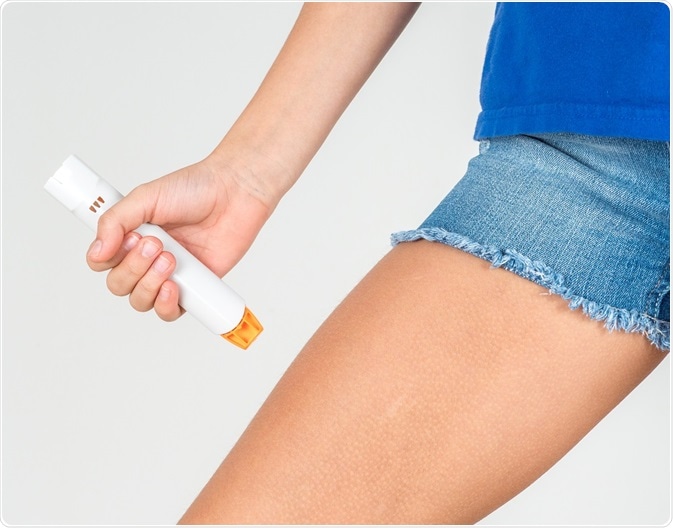
What is an Adrenaline Auto Injector?
Adrenaline (epinephrine) auto injectors are an approved emergency treatment for anaphylaxis.

Credit: Alexey Smolyanyy/Shutterstock.com
Anaphylaxis is a serious, potentially fatal allergic reaction. It can happen within seconds to minutes of exposure to an allergen, like an insect sting, medications, and food.
When the immune system mistakenly identifies a substance as harmful, it releases certain chemicals that cause allergy symptoms. In anaphylaxis, the release of the chemicals can cause the person to go into shock. Anaphylactic shock is a potentially fatal condition that is characterized by a drop in blood pressure, narrowing of the airways and difficulty in breathing.
An anaphylaxis can turn fatal within minutes of exposure to an allergen. Immediate access to adrenaline or epinephrine is critical during the first few minutes of an anaphylactic reaction.
Indications for use
Adrenaline auto injectors are indicated in the emergency treatment of severe allergic reactions to insect stings, including bees, hornets, wasps, fire ants and yellow jackets, and insect bites from triatoma and mosquitoes. Also, adrenaline or epinephrine auto injectors are used in the treatment of anaphylaxis due to foods, drugs, diagnostic testing chemicals or substances, allergen immunotherapy, and other allergens.
The immediate symptoms of anaphylaxis include pruritis, rashes, abdominal cramps, wheezing, the difficulty of breathing due to laryngeal spasm, angioedema, urticaria, flushing, syncope, apprehension, convulsions, diarrhea, vomiting, and thready pulse due to a fall in blood pressure.
How do adrenaline auto injectors work?
Adrenaline auto injectors deliver an adequate dosage of adrenaline or epinephrine. Adrenaline is a natural hormone released by the body in response to stress. It is secreted by the medulla of the of the adrenal glands.
Normally, strong emotions trigger the release of adrenaline, which will increase the heart rate, blood pressure, sugar metabolism and muscle strength. It instantly reverses the effects of an anaphylactic reaction by opening the airways, reducing throat swelling, and maintaining blood pressure and heart function.
How to use an adrenaline auto injector
The maximum effect of an adrenaline auto injector relies on the proper administration of the drug. The proper and accurate administration is vital. Injecting large doses or accidentally injecting the drug directly into a vein or artery may lead to cerebral hemorrhage due to a sudden increase in blood pressure.
How are adrenaline auto injectors administered?
Adrenaline auto injectors are prescribed to those who are having an anaphylaxis. These injections come with a pre-filled solution that automatically injects when pushed against the skin.
Make sure to inject the adrenaline on the anterolateral aspect of the thigh. Never inject the auto injector intravenously or in any other part of the body. The adrenaline auto injector should never be injected on the feet, hands or buttocks.
Injecting adrenaline into the buttocks has been associated with gas gangrene. On the other hand, injecting it into the feet or fingers may lead to loss of blood flow to the affected area.
Moreover, make sure to read manufacturer labels because each brand has a different mode of administration. This is to reduce the risk of injecting the adrenaline to other parts of the body or the administrator’s thumb. Also, the drug may not work if it’s injected incorrectly.
First aid for anaphylaxis
An anaphylaxis is a medical emergency. If someone is having an anaphylactic reaction, make sure to provide proper first aid to reduce the risk of complications.
- Lay the victim flat but if they are having a hard time breathing, allow to sit. Never allow the patient to walk or stand.
- Remove the trigger or prevent further exposure, if possible.
- Administer the adrenaline auto-injector based on the medicine’s label.
- Immediately after administration, call an ambulance or for emergency response, even if the patient’s condition is improving.
- Let the patient lie flat with the legs raised to maintain blood flow.
- If the auto-injector did not work or the person does not start feeling better, further adrenaline injection may be needed. The second auto-injector should be administered 5 to 15 minutes after the first one.
- If breathing stops, perform resuscitation and life support procedures until an ambulance arrives.
Adrenaline auto-injectors are crucial in the treatment of anaphylaxis, which is a fatal condition. Proper use of the drug plays a pivotal role in its efficacy. Hence, it is recommended for patients and their caregivers to receive proper training on administration. Healthcare professionals in clinics, schools, and communities should also undergo training on how to properly administer adrenaline auto-injectors.
Reviewed by Hardik Patel, M.Pharm.
Sources:
Further Reading
Last Updated: Apr 20, 2018





















.jpg)












No hay comentarios:
Publicar un comentario